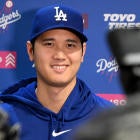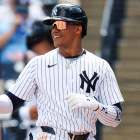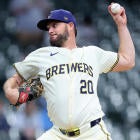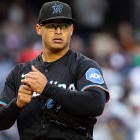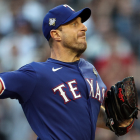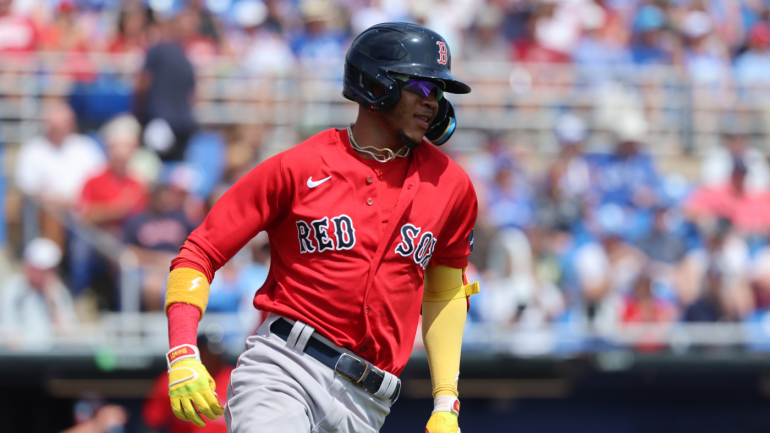
Major League Baseball's season has arrived, and that can mean only one thing: the Minor League Baseball campaign isn't far off. Indeed, Triple-A affiliates across the land will kick off their schedules on Saturday, March 30. To celebrate the occasion, we're bringing back the Prospect Watch column for another year of tracking and analyzing the league's best and most interesting young players.
For those new to the premise, Prospect Watch is typically a twice-monthly piece (one for the AL, one for the NL) that hits on at least one prospect for every MLB team. Sometimes we have a specific theme, sometimes it's more general. Seeing as how this is the first time out this year, we figured it would be a good occasion to dust off an old favorite topic: highlighting a player per organization who could enjoy a breakout season.
Do note that, for the purposes of this exercise, we've excluded any player who was ranked in our winter's ranking of the top three prospects in each organization. Once you're at that level, it's probably fair to say you've already established a high baseline.
With that out of the way, let's get to the good stuff.
Arizona Diamondbacks: MIF Jansel Luis
Luis just celebrated his 19th birthday in March, but he's already made an impression on rival evaluators. Last season, he batted .257/.310/.417 in 36 games at A-ball; those marks may not seem impressive on their own, yet they look better when the greater context is taken into consideration. For one, the affiliate as a whole hit .235/.322/.358 on the season; for another, Luis was an 18-year-old switch-hitting middle infielder with both good athleticism and budding power. Provided he continues to hold his own at such a young age, he's going to move up lists quickly.
Atlanta Braves: RHP Spencer Schwellenbach
Schwellenbach was a two-way talent at Nebraska before the Braves drafted him in 2021 and converted him to pitching full time. He subsequently required Tommy John surgery, putting his pro debut on ice until last season. Schwellenbach flew under the radar a bit despite amassing a 2.49 ERA and a 3.44 strikeout-to-walk ratio in 65 innings. We think he'll remind people this year why he was considered a top-60 talent -- especially if his control and swing-and-miss ability from this spring are a preview of things to come.
Baltimore Orioles: RHP Trace Bright
Bright is a well-constructed right-hander with an intriguing arsenal and troubling command. He racked up more than 13 strikeouts per nine innings last season (including a four-game stretch in Double-A) thanks to a mid-90s heater and a downer curveball. If Bright can muster more strikes -- and the odds seem against it given that he's walked more than four per nine dating back to his days at Auburn -- he could wind up slotting into the back of the Orioles rotation before the year closes. Otherwise, he might face a career in relief.
Boston Red Sox: OF Miguel Bleis
We've already explained why we expect a bigger season from Bleis, whose physical gifts hint at above-average power and athleticism. Alas, we thought the same was in order around this time last year. Instead, Bleis suffered a season-ending shoulder injury after batting .230/.282/.325 in 142 A-ball plate appearances. This is a place for happy thoughts, so we're choosing to remain optimistic.
Chicago Cubs: OF Owen Caissie
Caissie, a Canadian originally drafted by the Padres who came over to the Cubs in the Yu Darvish trade, has populated breakout lists for years. Why? Because he hits the ball very hard, including to the opposite-field bleachers, despite regularly being two or three years younger than his average opponent. We'll grant that Caissie swings and misses with enough regularity to give some evaluators pause, and that his ultimate upside could be capped if he's unable to keep his strikeout rate on the sunny side of 30%. Still, we think that he's going to find his way to the majors at some point this season, and that he might end up hitting some memorable home runs in the process.
Chicago White Sox: RHP Peyton Pallette
Those who keep up with the draft are familiar with Pallette's story. He was considered to be one of the better pitchers in the 2022 class heading into that spring, but he slipped to the second round after having his season wiped out by Tommy John surgery. He hasn't pitched much at all over the last four years, with his 72 innings in 2023 representing a new personal high. Pallette's delivery might remind you a little of Jeremy Hellickson's, in terms of his arm action and how lackadaisical it appears, yet his walk rate (over five per nine last season) sure won't. We can only hope that more repetitions will help him refine his location because there's a chance for his arsenal to feature three average or better offerings at maturation.
Cincinnati Reds: 3B Cam Collier
Collier benefited from a lot of helium heading into the 2022 draft because of the simple facts that he was young for the class and had already excelled against top junior college competition. Nearly two years on, he hasn't delivered the desired results to the Reds. Collier still shows signs of boasting above-average power (he recorded a few batted balls over 110 mph in 2023), but he slugged .356 last season and hit more than 50% of his batted balls into the ground. Collier will play this entire season at age 19. We're willing to give him another year to get it together.
Cleveland Guardians: C/1B Ralphy Velazquez
We're not sure if Velazquez, the 23rd pick in the draft, is going to be able to remain behind the plate for the long haul. However, we're more certain that he's going to be an asset whenever he steps to the dish. Velazquez has a mature left-handed swing and approach, as well as a good feel for making consistent (and often quality) contact. In other words, he's the rare kind of young catching prospect whose chances of making it to The Show aren't devastated if he has to move elsewhere.
Colorado Rockies: SS Dyan Jorge
The Rockies don't receive credit for much, but give them this: they've done a good job of identifying exciting shortstop talent, whether it's Ezequiel Tovar, Adael Amador, or, the man of the capsule. Jorge is tall and extremely thin, suggesting that he should be able to add muscle as he matures -- that's a good thing, seeing as how power isn't much a part of his game. Jorge has shown enough feel for contact and the zone that we think that combination, married with his above-average foot speed and tendency to put the ball on the ground, could result in a fun batting line over a full season in Fresno.
Detroit Tigers: C/1B Josue Briceno
Briceno will not celebrate his 20th birthday until September, making it all the more notable that he delivered a 111 mph double during a Spring Breakout game that qualified as the hardest-hit ball of the day -- hotter, even, than offerings from well-regarded prospects Spencer Jones and Xavier Isaac. Briceno already doesn't look like a catcher physically, and it's probably a sign that the Tigers have been cross-training him at first base. Still, he has some immense raw power and the chance to solidify himself as a very good offensive prospect in short order.
Houston Astros: RHP Miguel Ullola
We don't think Ullola has the delivery or the command projection to start at the big-league level. We do think he has the stuff, a promising fastball-breaking ball combination, to assert himself in a relief role. Opportunities are always tough to come by in Houston, but Ullola could move quickly if and when the Astros decide his future is in short spurts.
Kansas City Royals: OF Gavin Cross
Cross impressed so much during his junior season at Virginia Tech that the Royals selected him with the ninth pick. He had a miserable first full professional season, but we're willing to give him something of a pass after he revealed that he was dealing with Rocky Mountain Spotted Fever. This could amount to something of a make-or-break season for Cross. We're hoping for a happy development.
Los Angeles Angels: RHP Jack Kochanowicz
Kochanowicz, a 6-foot-7 right-hander, earned himself a quick promotion to Double-A last season after generating 63% ground balls in five High-A starts. He didn't fare nearly as well at keeping the ball on the dirt in Double-A, yielding nearly two home runs per nine and finishing the year with a 6.53 ERA. The Angels farm system is largely barren; they could use a good full season from Kochanowicz. If they get one, he might close the year by making his big-league debut.
Los Angeles Dodgers: OF Josue De Paula
We've already explained why we're in on De Paula. Here's part of what we wrote: We're not including De Paula because he was "fine." We're including him because we anticipate a shift into a higher gear sooner than later. He's an angular left-handed hitter with a mature swing and the room to add muscle as he ages. If all goes well, he could become a positive contributor in each of the triple-slash categories.
Miami Marlins: RHP Karson Milbrandt
Milbrant is a former third-round pick who posted a 5.00 ERA in 23 starts last season. Better days await him. Not only does he have good athleticism, boding well for improved control in due time, but he has a well-rounded arsenal that's led by a mid-90s fastball. Milbrant figures to begin the season in High-A. With any luck, he could end up spending a chunk of the year at Double-A, setting himself up to make his big-league debut sometime in 2025.
Milwaukee Brewers: 3B Eric Bitonti
Bitonti has been a popular name on the scouting circuit for some time. Unfortunately, he hasn't always been able to put things together. That would explain why he dropped to the third round last season despite boasting some of the best raw power in the class. We think highly of the Brewers' player development staff, to the extent that it wouldn't shock us if they're able to help Bitonti make good on his immense promise.
Minnesota Twins: OF DaShawn Keirsey Jr.
We'll admit it: Keirsey, who will turn 27 in May, is an atypical breakout pick. That said, what good is possessing the creative license if you won't abuse it from time to time? Truthfully, we're not sold on his ability to hit at the big-league level -- he's very aggressive and prone to whiffing -- but he's a fantastic athlete who can really get after it defensively. We can envision a scenario where he gets a big-league look sometime over the course of the season and makes a few defensive plays that leave an impression.
New York Mets: SS Marco Vargas
Rival evaluators were quick to say the Mets got the better end of their trade with the Marlins last deadline that sent righty David Robertson to Miami. (And that was before Robertson imploded several times down the stretch.) Vargas was the biggest reason for that assertion. He won't turn 19 until May, yet he was a standout performer in the complex league, hitting .283/.457/.442 prior to the deal. The Mets thought well enough of him to grant him a six-game cameo at A-ball to close out the year. That's where his story should begin this season.
New York Yankees: LHP Henry Lalane
Lalane is a young, tall (6-foot-7) left-hander with a promising foundation in place. He carved up complex league hitters last season, amassing an 8.50 strikeout-to-walk ratio in 21 innings thanks to a budding arsenal. His fastball has good rising action and can already touch into the upper-90s, and he shows promise with both his curveball and his changeup. Lalane has better pitchability than most of his peers of his age and size, too. Put a star next to his name. He could move up lists quickly.
Oakland Athletics: RHP Steven Echavarria
Echavarria hasn't yet made his professional debut after being drafted in the third round last summer. He saw his stock and velocity tick upward during the spring, giving him middle-of-the-rotation upside. He won't turn 19 until late in the season, and he has a chance to be regarded as one of the better prospects in the system sooner than later.
Philadelphia Phillies: SS Starlyn Caba
If you want to feel old, just consider that Caba was born about a month before the Diamondbacks traded Randy Johnson to the Yankees. If you want to feel better, pull up some footage of him playing. He has the makings of an impressive switch-hitting shortstop, complete with good athleticism and feel for contact.
Pittsburgh Pirates: RHP Braxton Ashcraft
It's a testament to some of the other arms in the Pirates system -- Paul Skenes and Jared Jones included -- that Ashcraft feels overlooked. He pitched well across three levels last year, showing above-average control over an arsenal led by a rising mid-90s fastball. Ashcraft isn't going to be first or second in line for a rotation spot, but we suspect he still might debut before the year is out.
St. Louis Cardinals: OF Chase Davis
Davis was one of the most improved players in college baseball last season, solidifying himself as a first-round pick by making impressive gains with his contact rates. Alas, his introduction to pro ball was putrid. He hit just .212/.366/.269 while recording nearly as many strikeouts in 34 pro games (34) as he had in 57 collegiate games (40). We're not going to give up on Davis just yet. Instead, we're doubling down by including him on this list.
San Diego Padres: SS Leodalis De Vries
We've already covered De Vries before. Here's part of what we wrote. The Padres signed De Vries for $4.2 million back in January. He was, at 17, considered to be the best international amateur free agent on the market thanks to a skill set that could end up featuring five above-average or better tools. De Vries hasn't yet made his professional debut, but we feel obligated to include him in this article anyway after what happened last year with Ethan Salas.
San Francisco Giants: RHP Hayden Birdsong
Maybe it's unfair to include Birdsong, who struck out 33 batters in 23 innings at Double-A to close out last year after blowing through Low- and High-A. We're doing it anyway because we sense that he's still flying under the radar. Birdsong throws a mid-90s fastball and a quality curveball, and he has the kind of frame that scouts have traditionally liked to see from their starting pitchers (he's listed at 6-foot-4, 215 pounds). The one thing holding back Birdsong has been his geography. He's reliably worked more than four batters per nine innings, calling into question if he'll ever possess even fringe-average command. Birdsong's capacity for racking up strikeouts may render that a moot issue. If he can throw just a few more strikes, he has a chance to figure into the Giants' rotation plans late this year.
Seattle Mariners: RHP Jeter Martinez
Martinez only celebrated his 18th birthday in February. You wouldn't know it watching him. He's big and physical, and he's already capable of touching into the upper 90s thanks to a delivery that sees him load into his back side. It should come as no surprise that Martinez needs to refine the rest of his game and is a long ways off from making it to the big leagues. There are a lot of intriguing right-tail outcomes here and he's worth keeping tabs on in the interim.
Tampa Bay Rays: OF Colton Ledbetter
We've been Ledbetter fans dating back to last spring. He fell to the Rays in the second round, and we think they're going to end up happy with that development, even if he lacks a clear carrying tool. He's a well-rounded outfielder with a track record of performing who could move up the organizational depth chart in a hurry. Expect him to force his way to Double-A before the year closes.
Texas Rangers: RHP Aidan Curry
Curry, a former undrafted free agent, had a rough end to last season. He issued 10 walks and surrendered three home runs in 6 1/3 innings in his introduction to the High-A level. We're not too concerned. He projects to have both a starter's arsenal and command, and we think he's a decent bet to continue outperforming some of the more famous names in the Rangers system.
Toronto Blue Jays: RHP Juaron Watts-Brown
Watts-Brown was considered a potential first-round pick entering last spring. Unfortunately, he scuffled at Oklahoma State and ended up slipping to the third round. That could prove to be a lucky break for the Blue Jays. Watts-Brown has good stuff and athleticism. If they can get him around the plate more often, he has a chance to develop into a middle-of-the-rotation starter.
Washington Nationals: OF Cristhian Vaquero
Vaquero, a native Cuban, isn't far removed from receiving a $4.9 million signing bonus to join the Nationals in 2021. He's since slid down prospect ranking as the Nationals' system has fattened up with draft picks and trade returns, but that doesn't mean he's a nonentity. Vaquero is an angular switch-hitter who batted .279/.410/.393 in the complex league before receiving a forgettable 16-game look in A-ball, where he's likely to spend this year. He's a center field-quality athlete with a good arm who has shown a willingness to walk. Vaquero still needs to make good on his power promise, but we're willing to give him a wider berth given that he won't celebrate his 20th birthday until September.














